Gulf Region - history and present (+Bahrain)
Journeys to the Gulf, 40 years ago and present (+ Bahrain 09)
The biggest market for Pozzocrete which Dirk India produces has been for many years the Gulf Region (the product can be used as a partial cement replacement in concrete - resulting in cost savings, improved quality of concrete and environmental benefits).
www.pozzocrete.co.in
Therefore, from the very beginning of my stay in India, we have made frequent business trips to Bahrain, Qatar, Emirates, Oman and Kuwait. These countries are at a different stage of development, both economically and socially, and have varying degrees of tolerance and civil liberties. The most conservative is the Kingdom of Saudi Arabia, where we failed to get a visa or me - of course I would be allowed to go there only when accompanied by my husband - but even so there were insurmountable obstacles.
The attitude to women in the individual states usually shows the level of civil liberties granted to other citizens as well. Back in 2006, just at the beginning of my career as Export Director, when I was still insecure how to promote the fly ash, I was unexpectedly forced to go for a business trip to the Gulf region on my own. I visited customers in the UAE , Qatar, Bahrain and even in Kuwait, where we had no distributor – but it caused no problem that I was a woman (that would be impossible in Saudi Arabia). In the sequence of openness of the society, the first would be the Emirates, Qatar and Bahrain would be in the second and third place, followed by the Sultanate of Oman and Kuwait, which are more conservative.
The most liberal of these countries are the United Arab Emirates. This conglomerate of smaller emirates was loosely managed till the early 19th century by the Ottoman Empire and known as the Pirate Coast. It was a base of pirates who disrupted sailing of foreign cruise ships in the Persian Gulf. This led the British to organize expeditions to ensure a safe passage. In 1820, the British reached first a temporary and then permanent maritime "truce" and changed the name of the Pirate Coast (in German Seeräuberküste) to the Trucial States.
Brief history of the region
Each country has developed its own specific features, but some events in the past which affected the Pirate Coast, were effecting the whole region. For a long time the territory of the Persian Gulf was under the influence of the Persian Empire. An important change came through the adoption of Islam in the 7th century, allegedly brought at the hands of ambassadors of the Prophet Muhammad himself. In the 15th and 16th century the territory was freely administered by the Ottoman Empire, followed by eighty years of Portuguese rule. In the early 17th century the influence returned to the Persians, who with the help of the British fleet drove the Portuguese out. The British have achieved varying degrees of political control over the Gulf States during the years 1763 to 1971. Their influence was reinforced by the Agreement of 1892, according to which the Trucial States should not maintain diplomatic relations with any country without consent of Britain, and in turn, the British should provide security at sea and on land (“British protectorate”) . It was also a period of flourishing pearl trade which continued till the end of the 19th and early 20th century. However, both world wars, the economic crisis in Europe, start of the pearl breeding and subsequent imposition of duties on local pearls from India inflicted to this sector a fatal blow.
When we landed at the port of Dubai in 1970 on the way from Bombay to Basra (Iraq), the Trucial States looked mostly like a barren desert. There were about fifteen houses of European style for some businessmen of European or American origin, a modest mosque, otherwise we could see only tribal huts, traditional fishing boats departing for fishing and Bedouins riding on their camels.
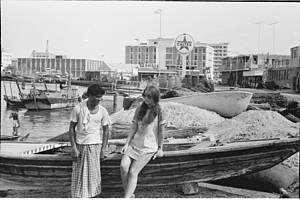
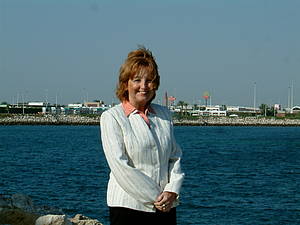
00 - Ivana at the seaside Trucial States 1970, Bahrain 2010
Kuwait, the next port where we landed, was the richest in the region at that time. I remember a long row of small goldsmith shops, full of gold, something like that I have never seen before. And there were already contradictions there – camels and huge American cars, sleeping outside or in European style houses.
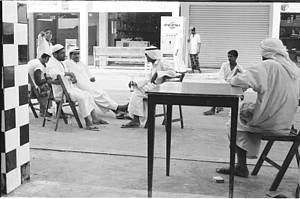
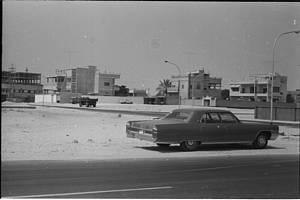
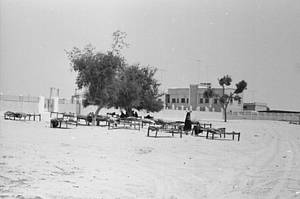
00a – Kuwait 1970
Although the first oil was discovered already in the thirties and forties of the 20th century, the residents did not have the oil drilling technology in the sea till the early seventies. Only in 1971, when the United Arab Emirates were created, the Gulf States began to realize what treasure in the form of oil and natural gas they could get their hands on.
The biggest problem was water. Various cities in the history of mankind perished for lack of water, but the Gulf inhabitants achieved the impossible - with funds obtained from petroleum they built the expensive and technical demanding systems for desalination of seawater and started to produce drinking water from it. With the help of irrigation, the Emirates, Qatar, and Kuwait started to create new areas where it was possible to grow crops and to establish new parks and green oasis.
Then the prosperity was round the corner. First it was necessary to build the infrastructure, new roads and airports, as well as schools, universities, hospitals, mosques and administrative buildings. In the second stage of boom, structures important for development of tourism were created - skyscrapers designed by world-renowned architects and huge entertainment industry, including extravagant slopes for skiing, skating rinks, water worlds, amusement parks, stadiums, golf courses and huge department stores. Funds for the development have been coming from oil and gas into the state coffers continuously, but some of the states are aware that it will not last for ever, that is why e.g. Dubai is already getting a great part of its revenues from tourism.
The citizens of these countries have one of the highest living standards in the world. It looks different for immigrants ( from India , Pakistan, Bangladesh, Malaysia and other countries), who helped to built this wealth by their hard work, but are considered second-class citizens without any rights and have nearly no chance to obtain the citizenship.
Bahrain 2009
One of the less known and less visited Gulf countries are small islands of Kingdom of Bahrain, therefore I would like to write more about it. We have visited Bahrain many times, we organized a seminar for designers, consultants and engineers and participated in various conferences. This report comes from the seminar in October 2009.
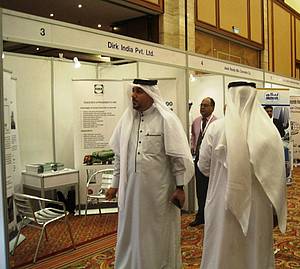
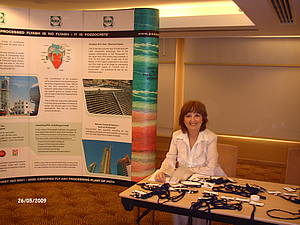
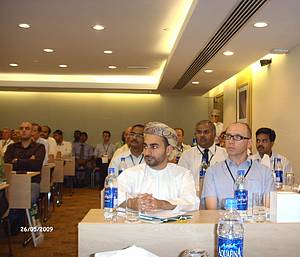
01 – Seminars and conferences
Geographical location: Imagine on the map the Persian Gulf (which is generally called Gulf, but in Iran you must call it Persian Gulf, the name Gulf used by Arabs is in Iran politically incorrect – anyway, it is called Persian Gulf in Czech and German as well). The Arabian peninsula is lying at the eastern side of the Persian Gulf – better known countries like United Arab Emirates and Qatar are bordering the Persian Gulf. Bahrain Islands are situated in the sea only by 20 minutes flight from Doha, which is the capital of Qatar. The Islands are connected to the mainland by a bridge leading to Saudi Arabia (called King Fahd Causeway, opened in 1986) and there are plans for construction of the longest bridge in the world, which would connect Bahrain to Qatar.
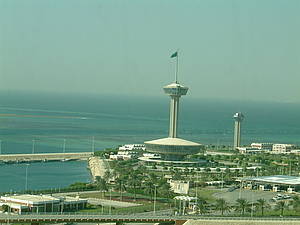
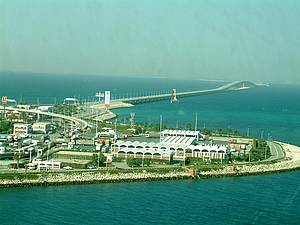
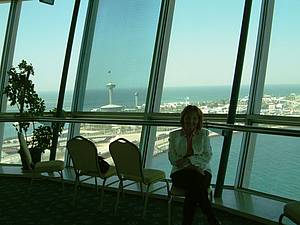
02 – On the Border Between Bahrain and Saudi Arabia
The name Mamlakat al-Bahrayn in Arabic means Kingdom of the Two Seas. From the economic point of view the country possesses oil resources and pearls, which is a good combination. At the time of our stay in 2009 there was still no Arab Spring around and the construction was booming. Among other projects Bahraini people planned to build the tallest skyscraper in the world, MurjanTower, which should be 1,022 meters high (designed Danish architect Henning Larsen). For comparison, the highest skyscraper which was in the time of our visit still under construction Burj Dubai (Burj Khalifa) has 818 meters, World Trade Center had (and after the recovery will have) 417 m, Empire State Building is 381 meters high. Whoever had a chance to visit New York must be aware that already sky scrapers in New York are high enough
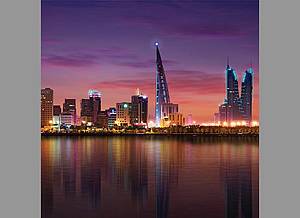
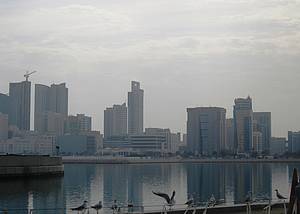
03 – Bahrain Skyline
History
It is a complicated story of fights for political and religious influence, as usual in the region.
· Inhabited since ancient times, Bahrain was ruled by Assyrians and Babylonians. Then it came under control of Persians from Iran. Until 629, before Islam took over, the country was a center of Nestorian Christians.
· Qarmatians, a millenarian Ismaili Muslim sect, conquered Bahrain in the year 899 and tried to create a utopian society with the egalitarian division of all property. Generally, this sect caused a great unrest in the Islamic world, and at certain times was quite powerful - they even collected tribute from the Caliph of Baghdad, and conquered Mecca and Medina in 930. From Mecca they took away the Black Stone, a stone which, according to the Islamic tradition, fell out of the sky to show Adam and Eve where to build an altar for sacrifices to the gods. Muslims believe that the stone was originally snow-white, but as time went by it became black because it absorbed the sins of mankind. The stone was returned to Great Mosque of Kufa in Iraq twenty-two years later under equally mysterious circumstances. It was wrapped in a sack and thrown into Mosque on Friday with the inscription "According to the order we took it, as ordered we give it back." Unfortunately, the stone was broken into seven pieces. Presently it is exhibited in Mecca glued together and fastened into a silver frame
· Starting 1521 there were 80 years of Portuguese rule. Later the Portuguese were chased away by Safavid Dynasty, originating again from Iran, which introduced the Shiite branch of Islam as the official religion.
· Since 1783, Arabic tribe Aal Bin Ali, whose members were originally sailors, started to rule the islands. In a practical sense, the country gained independence, for example, it had its flag, which was erected during the times of war, during the season of pearl fishing and on other festive occasions (weddings, Eid, etc.)
· In 1820, Al Khalifa dynasty, a Sunni family that reigns Bahrain until today came to power. The current head of the family is Hamad ibn Isa Al Khalifa, who became in 1999 Emir, and 2002 obtained the title of the King. From the very beginning, the dynasty cooperated with the British who were in the 19th century the dominant military power in the Persian Gulf.
· From 1926 to 1942 the islands underwent an important social reform. Charles Belgrave, the British advisor to Sheikh Hamad Isa Al Khalifa was de facto the ruler of the country at that time. New schools and hospitals were established (the first school for girls in the Persian Gulf opened in Bahrain in 1928), slavery abolished etc.
· After World War II the anti-British sentiments spread in the country which led to the violence directed specifically against the Jewish community. The result was that the most Jews evacuated after 1947, first to Bombay and then to Palestine/Israel. They had never received any compensation for property which they had to abandon.
· In 1970, Iran raised the claim to Bahrain and other islands, but in agreement with the United Kingdom, it was decided that Iran would not uphold it. The population confirmed its Arab identity in a referendum. The British left the country in 1971 and the islands were declared an independent emirate.
· Economically, the Kingdom is primarily dependent on the extraction of oil with all the advantages and disadvantages it brings. The country greatly benefited from the civil war in Lebanon in the early seventies, when Bahrain replaced Beirut in its role as the financial center for the Middle East.
· In the mid-nineties, the country was hit by the wave of violence triggered by government opposition led by clerics (similarly to the situation in Iran in the seventies). More than forty people were killed, but the clerics did not succeed.
· In 1999 Hamad ibn Isa Al Khalifa ascended the throne. He introduced universal suffrage for women and released political prisoners. Since 2002, Bahrain became officially a Kingdom.

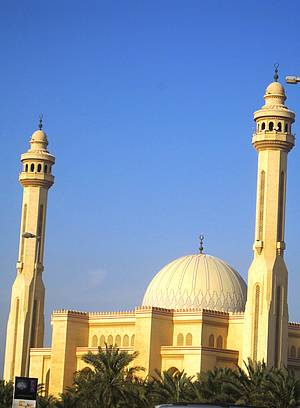
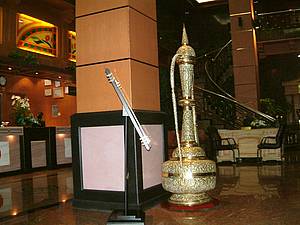
04 – Decorations and tradition
How we experienced the country:
We went to Bahrain for a seminar that we organized in cooperation with our distributor. The lectures were held by Professor Dhir, OBE (the recipient of the Order of the British Empire, Professor Emeritus of the University of Dundee in Scotland) and also by George who lectured on the environmental aspects of fly ash processing. Considering the fact that Bahrain has only around eight hundred thousand inhabitants, the participation of 80 of them was great. However, some of the participants reached also from the neighboring Kingdom of Saudi Arabia. A team of two filmmakers who came with us from India was shooting a film about the environmental processing and utilization of fly ash in the seminar hall but also in the town (ready-mix plants, construction sites, completed projects, especially skyscrapers built with Pozzocrete etc.)
I had some interesting experience showing the diversity of customs when I got in touch with the citizens of Saudi Arabia. One of the professors of the University of Riyadh had arrived the previous evening with his wife. The next morning he came with her to the registration desk and made introductions - she had her face covered (as the only one, all other women had only a scarf). It was a strange feeling, because I started to talk to her but I could not see her face (I have never spoken to a veiled woman before). I think that her husband must have seen my uneasiness and he told her that she was allowed to uncover her face because it was a private venue. So the woman lifted the veil from her face, fastened it to her hair (I think with relief), and we were able to have conversation face to face.
All male guests from Saudi Arabia had traditional distinctive head coverings called guthra, a white or red and white checkered cloth held in place by the agal, a black type of rope which was in the original desert culture a camel tether.
We were handing out all participants of the seminar badges with their names which they placed t around the neck. After the seminar was over, they were supposed to give these badges back. But it was sometimes difficult both for women in their headscarves and for the sheiks in their guthra to take the badge off because they got entangled in cords. I stood next to one sheik, who just could not untangle himself. Normally I would help him, but I already knew the habits of the country: when the sheik is orthodox, he even does not shake hands with a woman, not speaking about touching her – and of course, I was not allowed to touch him either. After some time I was embarrassed just to stand by and to watch, so I told him that I would like to help him but probably better not... He understood what I meant, smiled and said, never mind, could you please help me? So I was allowed to touch the sheik and disentangle him from the cord entangled in his guthra. It was good that common sense prevailed.
Other episodes connected with traveling:
On departure from Bahrain an immigration official (in scarf) asked several times from which country I came from (which is quite common, as many people in the Czech Republic or in Europe have never heard of Bahrain, many Bahraini inhabitants have never heard of the Czech Republic). She looked at the computer and could not find my registration there. She handed my passport to the colleague sitting opposite. Long search followed, again nothing. Her colleague gave the passport to another colleague. No result, there was some hitch there. The colleague called his superior, who finally explained to me that they could not find the number of my visa, which they saw on arrival. Do I have a confirmation of payment? The visa was prepaid by our distributor, so I did not have any confirmation with me. The official took the passport, went off and did not return for a long time. At that moment it occurred to me that there might be a solution, as I had a scanned copy of the payment slip on the laptop. I pulled out my lap top, put it on the counter of the immigration officer, started it, and found the respective email. The official was relieved because she could pair my arrival to my departure, and I was released. It almost seemed that otherwise I would have to stay in Bahrain.
Upon arrival in Mumbai there was another incident, this time luckily not concerning me. That was the time of swine flu epidemics. One of the filmmakers got sunstroke in Bahrain and to my surprise, the cameras installed at the airport to measure remotely the temperature of all passengers who passed through actually discovered that he had a fever (I had always suspected that these cameras were there just for decoration and that nobody was really paying any attention to them, in a typical Indian way, but it turned out that in this case, I was wrong). The unlucky filmmaker was immediately put into isolation not to spread swine flu which he did not have. It did not help when he said that he had no cough or runny nose, or that his throat did not hurt him at all, that he said that he had just stayed too long in the tropical sun. We had to leave him to his fate (originally he was supposed to come with us to Nashik by car). Eventually, he managed to set himself free by paying thousand rupees (no receipt, of course, that was already a typical Indian way again).
September 2013 – final note: Political situation in Bahrain deteriorated in the last years. The problems began when the country was caught up in the Arab Spring, a revolutionary wave of demonstrations and civil wars in the Arab world, at the start of 2011. The Shiite majority protested against the rule of Al-Khalifa family (in power more than 200 years), which belongs to Sunnite minority. The demonstrations were subdued by force and with help of the neighboring Saudi Arabian army, but since then the protests, barricades, burning tires and other violent actions are repeated again and again and have a negative influence on the country´s economy.
Pictures from our various visits to the Gulf region:
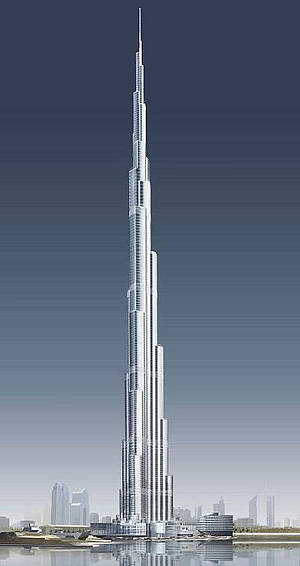
05 – Emirates – Burj Khalifa - the highest building in the world
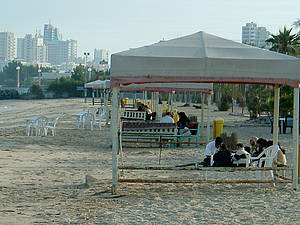
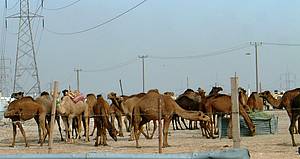
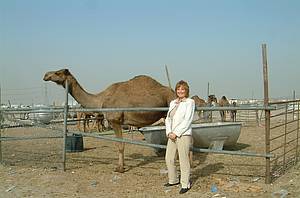
06 – Kuwait Traditional

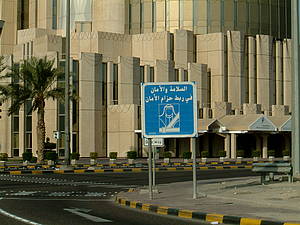
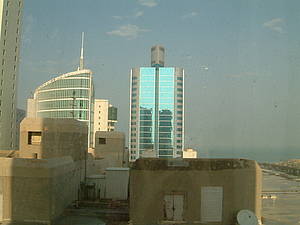
07 – Kuwait Modern
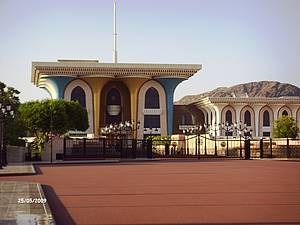
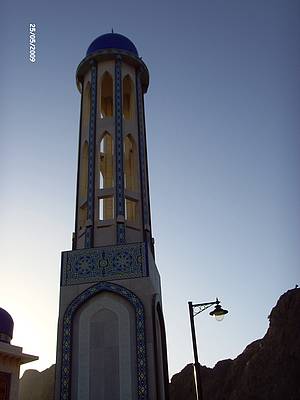

08 – Oman – Architecture
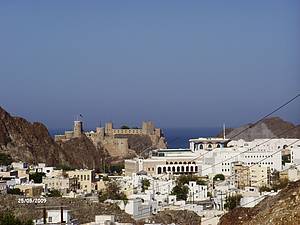
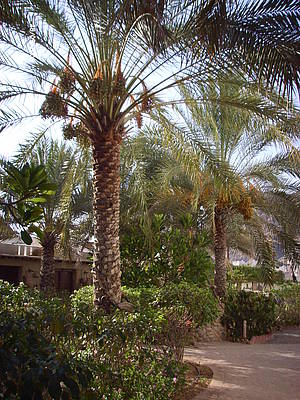
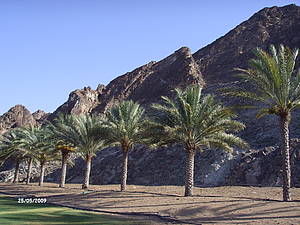
09 – Oman – Nature - date palms, rocks and sea
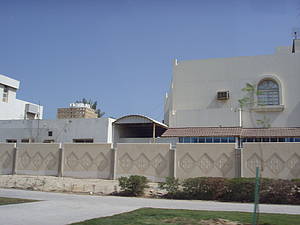
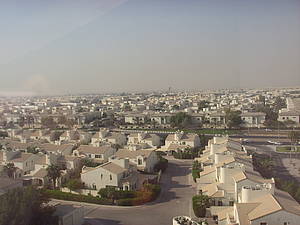
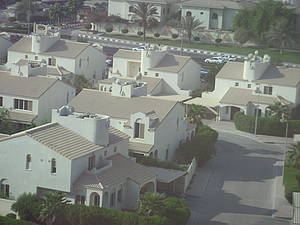
10 – Qatar – housing projects
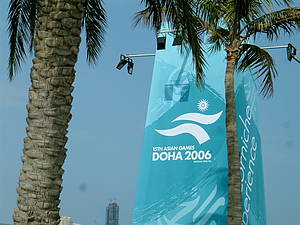
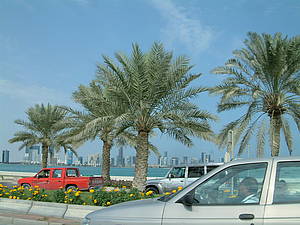
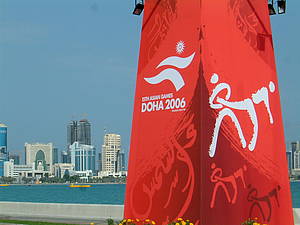
11 – Qatar – modern - 15th Asian Games
Bahrain Islands - Seminar 19th October 2009
Because only a few people know about Bahrain Islands I would like to write down interesting things which we have learned and experienced.
First of all, where is Bahrain situated. Imagine on the map the Persian Gulf (which is generally called Gulf, but in Iran you must call it Persian Gulf, the name Gulf used by Arabs is in Iran politically incorrect – anyway, it is called Persian Gulf in Czech and German as well). The Arabian peninsula is lying at the eastern side of the Persian Gulf – better known countries like United Arab Emirates and Qatar are bordering the Persian Gulf. Bahrain Islands are situated in the sea only 20 minutes by plane from Doha, which is the capital of Qatar. The Islands are connected to the mainland by a bridge leading to Saudi Arabia (called King Fahd Causeway, opened in 1986) and there are plans for construction of the longest bridge in the world, which would connect Bahrain to Qatar. The name Mamlakat al-Bahrayn in Arabic means Kingdom of the Two Seas. From the economic point of view the country possesses oil resources and pearls, which is a pretty good combination. At the time of our stay there was still no Arab Spring around and the construction was booming. Among other projects Bahraini people planned to build the tallest skyscraper in the world, Murjan Tower, which should be 1,022 meters high (designed Danish architect Henning Larsen). For comparison, the highest skyscraper which was in the time of our visit still under construction Burj Dubai (Burj Khalifa) has 818 meters, World Trade Center had (and after the recovery will have) 417 m, Empire State Building is 381 meters high. Whoever had a chance to visit New York must be aware that already sky scrapers in New York are very high.
History – complicated story of fights for political and religious influence, as usual in the region.
· Inhabited since ancient times, Bahrain was ruled by Assyrians and Babylonians. Then it came under control of Persians from Iran. Until 629, before Islam took over, the country was a center of Nestorian Christians.
· Qarmatians, a millenarian Ismaili Muslim sect conquered Bahrain in the year 899 and tried to create a utopian society with the egalitarian division of all property. Generally, this sect caused a great unrest in the Islamic world, and at certain times was quite powerful - they even collected tribute from the Caliph of Baghdad, and conquered Mecca and Medina in 930. From Mecca they took away the Black Stone, a stone which, according to the Islamic tradition fell out of the sky to show Adam and Eve where to build an altar for sacrifices to the gods. Muslims believe that the stone was originally snow-white, but as time went it became black because it absorbed the sins of mankind. The stone was returned to Great Mosque of Kufa in Iraq twenty-two years later under equally mysterious circumstances. It was wrapped in a sack and thrown into Mosque on Friday with the inscription "According to the order we took it, as ordered we give it back." Unfortunately, the stone was broken into seven pieces. Presently it is exhibited in Mecca glued together and fastened into a silver frame
· Starting 1521 there were 80 years of Portuguese rule. Later the Portuguese were chased away by Safavid Dynasty, originating again from Iran, which introduced the Shiite branch of Islam as the official religion.
· Since 1783, Arabic tribe Aal Bin Ali, whose members were originally sailors, started to rule the islands. In a practical sense, the country gained independence, for example, it had its flag, which was erected during the times of war, during the season of pearl fishing and on other festive occasions (weddings, Eid, etc.)
· In 1820, Al Khalifa dynasty, a Sunni family that reigns Bahrain until today came to power. The current head of the family is Hamad ibn Isa Al Khalifa, who became in 1999 Emir, and 2002 obtained the title of the King. From the very beginning, the dynasty cooperated with the British who were in the 19th century the dominant military power in the Persian Gulf.
· From 1926 to 1942 the islands underwent an important social reform. Charles Belgrave, the British advisor to Sheikh Hamad Isa Al Khalifa was de facto the ruler of the country at that time. New schools and hospitals were established (the first school for girls in the Persian Gulf opened in Bahrain in 1928), slavery abolished etc.
· After World War II the anti-British sentiments spread in the country which led to the violence directed specifically against the Jewish community. The result was that the most Jews evacuated after 1947, first to Bombay and then to Palestine/Israel. They had never received any compensation for property which they had to abandon in the country
· In 1970, Iran raised the claim to Bahrain and other islands, but in agreement with the United Kingdom, it was decided that Iran would not apply its claim to Bahrain. The population confirmed its Arab identity in a referendum. The British left the country in 1971 and the islands were declared an independent emirate.
· Economically, the Kingdom is primarily dependent on the extraction of oil with all the advantages and disadvantages it brings. The country greatly benefited from the civil war in Lebanon in the early seventies, when Bahrain replaced Beirut in its role as the financial center for the Middle East.
· In the mid-nineties, the country was hit by the wave of violence triggered by government opposition led by clerics (similarly to the situation in Iran in the seventies). More than forty people were killed, but the clerics did not succeed.
· In 1999 Hamad ibn Isa Al Khalifa ascended the throne. He introduced universal suffrage for women and released political prisoners. Since 2002, Bahrain became officially a Kingdom.
How we experienced the country:
We went to Bahrain for a seminar that we organized in cooperation with our distributor Ali Rashid Al Amin. The lectures were held by Professor Dhir, OBE (the recipient of the Order of the British Empire, Professor Emeritus of the University of Dundee in Scotland) and also by George on the environmental aspects of the processing of fly ash. Considering the fact that Bahrain has only around eight hundred thousand inhabitants, the participation of 80 of them was great. However, some of the participants reached also from the neighboring Kingdom of Saudi Arabia. A team of two filmmakers came with us from India who were shooting a film about the environmental processing and utilization of fly ash, during the conference and also in the city (in ready-mix plants, construction sites, completed projects, especially skyscrapers built with Pozzocrete etc.)
I had some new experience in connection with different culture with citizens of Saudi Arabia. One of the professors of the University of Riyadh had arrived the previous evening with his wife. The next morning he came with her to the registration desk and made introductions - she had her face covered (as the only one, all other women had only a scarf). It was a strange feeling, because I started to talk to her but I could not see her face (I have never spoken to a veiled woman before). I think that her husband must have seen my uneasiness and he told her that she was allowed to uncover her face because it was a private venue. So the woman lifted the veil from her face, fastened it to her hair (I think with relief), and we were able to have conversation face to face. All male guests from Saudi Arabia had traditional, distinctive head coverings called guthra, a white or red and white checkered cloth held in place by the agal, a black type of rope which was in the original desert culture a camel tether.
We were handing out all participants of the seminar badges with their names which they put around the neck. After the seminar was over, they were supposed to give these badges back. But both for women in their headscarves and for the sheiks in their guthra fastened by agal it was sometimes difficult to take it off because they got entangled in cords. I stood next to one sheik, who just could not untangle himself. Normally I would help him, but I already had the cultural experience: when the sheik is orthodox, he even does not shake hands with a woman, not speaking about touching her – and I was not allowed to touch him either. After some time I was embarrassed just to stand by and to watch, so I told him that I would like to help him but probably better not... He understood what I meant but said, never mind, could you please help me? So I was allowed to touch the sheik and disentangle him from the cord entangled in his guthra. It was good that common sense prevailed.
Other episodes are connected with travelling. On departure from Bahrain an immigration official (in scarf) asked several times from which country I came from (which is quite common, as many people in the Czech Republic or in Europe have never heard of Bahrain, many Bahraini inhabitants have never heard of the Czech Republic). She looked at the computer and could not find my registration there. She handed my passport to the colleague sitting opposite. Long search followed, again nothing. Her colleague gave the passport to another colleague. No result, there was some hitch there. The colleague called his superior, who finally explained to me that they could not find the number of my visa, which they saw on arrival. Do I have a confirmation of payment? The visa was prepaid by our distributor, so I did not have any confirmation with me. The official took the passport, went off and did not return for a long time. At that moment it occurred to me that there might be a solution, as I had a scanned copy of the payment slip on my laptop. I pulled out my lap top, put it on the counter of the immigration officer, started it, and found the respective email. The official was relieved because he could pair my arrival to my departure, and I was released. It almost seemed that otherwise I would have to stay in Bahrain.
Upon arrival in Mumbai there was another incident, this time luckily not concerning me. One of the filmmakers got sunstroke in Bahrain and to my surprise, the cameras installed at the airport to measure remotely the temperature of all passengers who passed through actually discovered that he had a fever (I had always suspected that these cameras were there just for decoration and that nobody was really paying any attention to them, in a typical Indian way, but it turned out that in this case, I was wrong). The unlucky filmmaker was immediately put into isolation not to spread swine flu which he did not have but that was the time of swine flu epidemics. It did not help when he said that he had no cough or runny nose, or that his throat did not hurt him at all, that he had just stayed too long in the tropical sun. We had to leave him to his fate (originally he was supposed to come with us to Nashik by car). Eventually, he managed to set himself free by paying thousand rupees (no receipt, of course, that was already a typical Indian way again).


